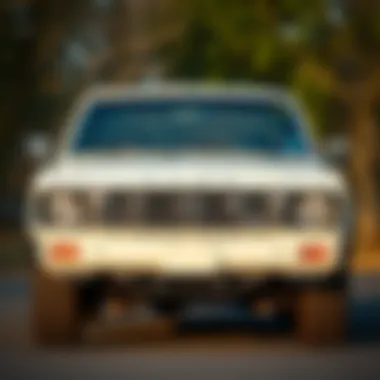An In-Depth Look at Used Mazda B Series Trucks


Market Research Overview
The automotive market has seen significant changes in recent years, particularly concerning used vehicles. The used Mazda B Series trucks have carved out a niche, attracting attention from a diverse demographic. Understanding the current market trends and the interests of consumers looking at these trucks will provide valuable insights for potential buyers.
Industry Trends and Insights
The used truck market has evolved, with an increasing emphasis on reliability, fuel efficiency, and affordability. The Mazda B Series, produced between 1972 and 1993, presents an interesting case due to its unique blend of features and specifications. As sustainability becomes a larger concern, many buyers opt for older, more durable truck models that can be maintained affordably without compromising on essential functions.
- Increased Demand for Compact Trucks: Nowadays, buyers are leaning towards compact pickup trucks due to their versatility and ease of maneuverability.
- Value of Older Models: Classic vehicles, particularly those with a reputation for reliability, tend to hold their value. For example, the B Series models are often seen as enduring options for light hauling.
- Online Marketplaces: Platforms like Facebook Marketplace and Reddit have enabled enthusiasts to connect, discover, and trade vehicles at competitive prices. This evolution has fueled a vibrant community centered around the Mazda B Series.
Consumer Demographics
The typical consumers interested in the Mazda B Series are primarily individuals who appreciate function over flash. They are often DIY enthusiasts, mechanics, or collectors, and their purchasing decisions are influenced by a blend of practicality and nostalgia. Here’s a breakdown of some notable demographics:
- Age Range: Predominantly falls between 30 to 50 years, people who may have grown up with vehicles from this era.
- Purchasing Motivations: Many seek vehicles that offer durability for work or leisure. Fuel efficiency and ease of maintenance are essential factors for decision-making.
- Geographic Distribution: Interest spans across urban and rural areas, with rural buyers often requiring a truck for agriculture or tradesman purposes.
"Understanding the motivations and needs of the demographic is key to navigating the market effectively."
The resurgence in interest for the Mazda B Series showcases how consumer preferences are shifting towards durable, reliable vehicles that can serve a myriad of purposes, from daily commutes to adventurous excursions.
In the following sections, a detailed analysis of user experiences and ratings will further illuminate the aspects of the B Series, providing a deeper understanding for current and prospective buyers.
Overview of the Mazda B Series
The Mazda B Series represents a significant chapter in the story of compact trucks, showcasing Mazda's approach to functionality melded with a certain flair. Understanding the B Series is not just an academic exploration but also vital for potential buyers and automotive enthusiasts alike. This segment aims to dissect the essence of the B Series, outlining historical contexts while projecting its market positioning.
Historical Context
Originating in the early 1960s, the Mazda B Series began as a straightforward, utilitarian offering. The birth of this line is rooted in Mazda's desire to tap into the light truck market—a move that turned out to be quite prescient. From its early iterations, which boasted of basic performance and minimal frills, to contemporary models that incorporate more robust engineering, the evolution reflects changing consumer expectations. Over the decades, the B Series has had its share of collaborators, with Ford and Mazda partnering to produce the Ford Ranger in various markets.
A noteworthy aspect is its global presence. While American consumers became quite familiar with the B Series in the 1980s and 1990s, international markets saw its adaptability to local needs. It was, after all, a truck that could be found in bustling city streets or rugged rural pathways. As the automotive landscape shifted, the B Series has adapted—though it’s gently faded into the background as Mazda shifted its focus. This historical context serves not just as a backdrop but as a lens to appreciate the model’s design choices and customer influences over time.
Market Positioning
In terms of market positioning, the B Series has often been regarded as a more economical alternative in the compact truck segment. Competing with heavyweights like the Ford Ranger and Toyota Tacoma, blue-collar workers often gravitated toward Mazda for its reputation for reliability and value.
However, the B Series carved out a niche that emphasized not just utility but also a bit of flair. Mazda's marketing campaigns historically targeted the youthful and adventurous spirit, appealing to those who saw the B Series not solely as a workhorse, but also as a vehicle that complemented an active lifestyle.
Key Points of Market Positioning:
- Price Point: Competitive against established rivals, appealing to budget-conscious consumers.
- Reliability Reputation: Known for longevity, which became a selling point over generations.
- Versatility: Sought after not just for work, but for personal use as well.
- Unique Appeal: Mazda’s engineering led to a distinctive driving experience, blending comfort with utility.
Technical Specifications
Understanding the technical specifications of the used Mazda B Series is paramount for potential buyers and enthusiasts alike. This section dissects the crucial elements of the vehicles, helping readers recognize how specifications directly influence performance, reliability, and overall satisfaction with the vehicle. Whether you're a first-time truck buyer or are simply looking to add a well-rounded vehicle to your collection, the specifications can help steer you in the right direction. Knowing the details can also offer insights into potential maintenance costs, fuel economy, and the adaptability of the truck to different driving conditions.
Engine Options
The Mazda B Series comes with a range of engine options that cater to various driving styles and needs. Generally, these trucks have relied on both inline-four and V6 engines over the years. The four-cylinder engines typically found in older models offer decent fuel efficiency and sufficient power for light-duty tasks. In contrast, later models with V6 options provide a more robust performance, especially useful for towing and hauling.
Choosing the right engine often depends on what prospective buyers plan to use the truck for. For example, if someone is looking to haul equipment regularly, opting for a model equipped with a V6 engine can be a wise choice due to its better torque. Think of it like choosing between a bicycle and a motorcycle; both can get you where you're going, but one is much better suited for carrying a heavy load.
Transmission Details
When it comes to transmission, the Mazda B Series offers both manual and automatic options, allowing buyers to select based on their driving comfort and preferences. Manual transmissions give a more hands-on driving experience, which is often preferred by automotive purists. On the other hand, automatic transmissions are typically favored for their ease of use and convenience, particularly in urban driving conditions.
In terms of durability, it should be noted that some owners have reported minor issues with the automatic transmissions, especially in earlier models. Routine maintenance, including fluid changes and inspections, can significantly extend the lifespan of these transmissions. For buyers, understanding the history of transmission maintenance in a used vehicle is crucial—like checking the oil in a used boat before heading out on the water.
Body Configurations


The body configurations in the Mazda B Series also provide valuable options for buyers. Enthusiasts will find a mix of regular cab, extended cab, and even compact variants. Each of these configurations serves different needs, from daily commuting to weekend adventures or even work-related tasks.
- Regular Cab: This is typically the lightest version, ideal for those who don’t need extra passenger space. It’s great for maneuverability and efficiency.
- Extended Cab: Perfect for someone who might need to carry additional passengers occasionally or prefers extra storage space behind the seats.
- Compact Variants: These can be a hit for urban dwellers who appreciate a smaller vehicle but still require utility features.
In summary, selecting the right body configuration is akin to picking the right tool for the job. Each configuration serves distinct purposes and knowing these can help buyers make more informed and satisfying choices.
"Understanding the specifications of the Mazda B Series is not just about numbers; it’s about finding the vehicle that meets your needs and lifestyle."
By delving into these technical specifications, potential buyers can approach their decision with clarity and confidence.
Performance Assessment
When it comes to evaluating a vehicle, performance assessment stands as a key pillar in the decision-making process. For the used Mazda B Series, this aspect encompasses various factors such as fuel efficiency, driving dynamics, and towing capacities. Understanding these elements not only helps potential buyers gauge the vehicle's capabilities but also aligns with buyer expectations regarding practicality and reliability. In this section, we will dissect these components, equipping readers with the essential insights needed to make an informed choice.
Fuel Efficiency
Fuel efficiency is often at the forefront of many buyers’ minds, particularly given the rising fuel costs and environmental considerations. The Mazda B Series generously offers models that can deliver decent miles per gallon, especially when compared to its contemporaries. Generally speaking, older trucks are sometimes fuel guzzlers, but the Mazda B models stand out with respectable ratings.
Typically, depending on the model year and the engine, users can expect around 18-24 miles per gallon in combined driving conditions. Prospective buyers should keep in mind that factors such as driving habits and maintenance significantly influence these numbers. A well-maintained engine is likely to perform better, improving fuel efficiency. Moreover, consideration of payload can also play a role; lighter loads often yield better fuel consumption.
Driving Dynamics
The driving dynamics of the Mazda B Series could very well be its secret weapon. One thing that sets this truck apart from the competition is its handling. Many owners talk about how nimble and responsive these vehicles feel. With a well-balanced chassis and responsive steering, driving the Mazda B Series can be described as almost car-like, which isn't something one usually expects from a pickup truck.
This truck can adeptly navigate tight spaces and winding roads, making it a solid choice for urban dwellers who need a vehicle for both work and play. Additionally, the suspension system often earns praise for absorbing bumps and rough terrain, providing a comfortable ride without sacrificing that connection to the road, transforming even the roughest trails into a more enjoyable experience.
Towing Capacities
Towing capabilities can make or break a pickup truck's utility, particularly for those who need to haul heavier loads. The Mazda B Series doesn’t disappoint here either, especially when it comes to specific models with upgraded engine options. Most of these trucks can typically handle towing capacities ranging from 2,000 to 3,500 pounds, depending on their configuration. This is quite compelling when one considers the medium-duty tasks such as hauling equipment or trailers.
Yet, it is crucial for buyers to recognize that these numbers can fluctuate based on variables such as the engine type, trailer type, and even the regional specifications of the vehicle. For those who plan to use this truck for regular towing, checking the owner’s manual for maximum towing specifications becomes essential.
In summary, performance assessment in the Mazda B Series illuminates critical aspects that inform potential buyers. With balanced fuel economy, impressive driving dynamics, and reliable towing capacities, these trucks offer a competitive edge within their category. Keeping these points in mind paves the way for a more insightful purchasing experience.
Whether contemplating a purchase for daily needs or work-related tasks, understanding these performance facets can significantly aid in selecting the right model and ensuring a satisfying ownership experience.
Common Issues and Reliability
When considering a used Mazda B Series truck, understanding common issues and overall reliability is key to making an informed decision. These vehicles are often valued by enthusiasts for their blend of functionality and performance, but like any older vehicle, they aren't without their quirks. Addressing reliability concerns can lead to a more satisfying ownership experience. Here, I will explore several critical elements, including maintenance considerations, typical complaints from owners, and what actual users think about the B Series.
Maintenance Considerations
Regular maintenance is vital for the longevity and reliability of any vehicle, and the Mazda B Series is no exception. Often, these trucks have a well-deserved reputation for durability, but neglecting routine maintenance can lead to pitfalls.
- Oil Changes: Keeping an eye on the oil changes is a must. Some owners swear by frequent oil changes, especially if they’ve modified the engine or drive it hard. Dirty oil can lead to engine wear and tear.
- Transmission Fluid: For those with automatic transmissions, regularly changing the transmission fluid is essential. Many owners report smoother shifts and a longer-lasting transmission when they've taken this step seriously.
- Suspension and Brakes: Over time, components like shock absorbers and brake pads tend to degrade as with any vehicle. It's wise to inspect these regularly, particularly for those who engage in heavy towing or off-road driving. Ensuring these essential elements are up to par helps in stable handling and safety.
Maintaining a Mazda B Series can sometimes feel like juggling chainsaws, but the payoff is a reliable workhorse that can handle daily tasks well.
Common Complaints
Every vehicle comes with a list of common complaints. For the Mazda B Series, a few recurring themes emerge in the conversation among former and current owners.
- Rust Issues: Particularly in models from the late 80s and early 90s, rust can rear its ugly head. Owners often notice corrosion on the fenders and undercarriage, especially in regions that see harsh winters and road treatment with salt.
- Engine Problems: Some have reported issues with the engine, particularly those related to oil consumption. While this doesn’t affect every truck, it's a point of contention that future buyers might want to investigate thoroughly before purchasing.
- Electrical Gremlins: A few owners mention that the electrical systems can exhibit erratic behavior as they age. Problems with turn signals or the stereo can crop up and seem to be part of the deal in older models.
Recognizing these common complaints helps potential buyers know where to focus their inspection efforts.
Owner Reviews
You can find a wealth of information from current and former Mazda B Series owners. The insights provided by genuine users can often paint a clearer picture than any brochure or review site.


- Reliability: Many users praise the B Series for its reliability, often sharing stories of their trucks lasting well over 200,000 miles with only minimal repairs. This reliability is often cited as a reason for their continued loyalty to the brand.
- Versatility: Owners enjoy the versatility the B Series offers. Whether using it for daily commuting, weekend adventures, or work-related hauling, its balance of comfort and capability is often highlighted in reviews.
"I’ve had mine for a decade. It’s had a few hiccups, sure, but there’s nothing quite like it for getting the job done and still having a bit of fun on the weekends."
— B Series Owner
This firsthand account resonates with many enthusiasts who appreciate a truck that can fulfill multiple roles in their lives.
Market Trends and Valuation
Understanding the market trends and valuation surrounding the Mazda B Series is crucial for anyone considering this vehicle. It sheds light on how the truck is perceived within the automotive market and what kind of investment a buyer might be making. Trends provide insights into supply and demand dynamics, which heavily influence resale values, while valuation helps buyers gauge what they should expect to pay—and what they might receive down the line when it’s time to sell.
Resale Values
The resale values of used Mazda B Series trucks give a clear picture of their overall standing in the market. Generally speaking, these trucks have fared quite well over the years in terms of value retention. Many owners report that well-maintained B Series vehicles can still command fairly high prices compared to similar models from other manufacturers. The typical depreciation curve for the Mazda B Series usually sits comfortably within the accepted range for used vehicles, which means that buyers can generally expect fair resale prospects when the time comes to part ways with their truck.
Factors influencing resale value include:
- Condition of the Vehicle: Maintained trucks with fewer dents, clear glass, and service records tend to retain their value more effectively.
- Mileage: Lower mileage often correlates with a higher resale value, as it suggests less wear and tear.
- Modifications: While some modifications can enhance appeal, others can detract from it, influencing how potential buyers perceive value.
"One owner of a 1994 Mazda B4000 reported that their truck appreciated in value instead of depreciated over time, largely due to its excellent condition and low mileage."
This anecdote underscores the importance of vehicle upkeep. If buyers can spot a well-kept unit, they may indeed be looking at a sound investment.
Buyer Demographics
Delving into who buys the Mazda B Series reveals a fascinating array of users. The demographic skews towards practical individuals, including construction workers, outdoor enthusiasts, and even families seeking reliable transportation. The truck's versatility and reputation for durability attract a broad spectrum of buyers.
Typical characteristics of Mazda B Series buyers often include:
- Age Range: Often varies from 20s to 50s, appealing to both younger buyers and seasoned truck owners.
- Income Level: Generally, these owners are often middle-income earners who appreciate affordability coupled with quality.
- Preferences: Those who prefer a truck that combines functionality with simpler, less flashy designs, which can be a refreshing escape from the often over-styled competition.
Understanding this demographic can guide sellers on how to market their vehicles appropriately—focusing on practical usage and reliability over purely aesthetic features.
Regional Price Variations
Regional price variations for used Mazda B Series trucks can be quite stark, painting a varied picture of the market depending on location. In urban areas, prices might be higher due to greater demand and limited supply, while rural areas may see lower pricing, reflecting different usage patterns.
Some points to consider about regional price variations include:
- Geographical Demand: Regions with higher construction and agricultural activity often see higher demand for trucks, driving up prices.
- Climate Impact: In regions where rust tends to be more prevalent, trucks in good condition can demand a premium.
- Fuel Costs: Areas with high fuel prices might see a shift towards smaller, fuel-efficient vehicles, affecting Trcuk prices.
For anyone interested in purchasing a Mazda B Series, it’s crucial to research regional listings to ensure they understand the local market dynamics, which can inform negotiation strategies effectively.
Comparative Analysis with Competitors
When it comes to the used Mazda B Series, understanding how it stacks up against its competitors is essential for potential buyers. This section aims to highlight key comparisons with other popular trucks in the same category, providing insights that can guide decision-making.
Against Ford Ranger
Mazda B Series and Ford Ranger share a common ground as compact pickups, appealing to a similar audience of those who need practical vehicles without sacrificing comfort. The Ford Ranger has garnered a reputation for its robustness, boasting powerful engine options and a formidable towing capacity. Owners often rave about its reliability, but some have pointed out its slightly higher price point and fading fuel economy in older models.
On the flip side, the Mazda B Series tends to offer a more refined driving experience. The steering feels tighter and more responsive, which can lead to a more engaging ride, especially for urban use. Buyers willing to take a closer look might find that while the Ranger often out-muscles, the B Series displays a pleasing balance between work and leisure capabilities.
Against Toyota Tacoma
When pitting the Mazda B Series against the Toyota Tacoma, one can't ignore Tacoma's stellar reputation in durability. Many consider the Tacoma one of the most capable off-road vehicles, equipped to tackle rugged terrain with reliability. However, the B Series tends to hold its own in other areas.
Fuel efficiency is where the B Series finds a leg up, boasting better mileage in some models compared to older Tacomas. Many Tacoma owners will attest to the expenses incurred with frequent visits to the gas station, especially in its thirstier configurations.
Additionally, while both trucks provide a wide range of features, the Mazda B Series often comes in at a lower entry price, making it an attractive option for those looking for value without compromising too much on quality.


Against Chevrolet S-10
The Chevrolet S-10 has long been a staple of the compact truck market, often epitomizing the straightforward workhorse image. One notable attribute of the S-10 is its extensive dealer network that ensures service and parts aren't hard to come by. Yet, in terms of interior comfort and overall driving experience, the Mazda B Series often takes the cake.
B Series trucks are designed with a touch of flair, giving drivers not just functionality but also style. Many drivers have noted how the cabin of the B Series feels more modern and stylish—elements that appeal to many buyers today.
Moreover, buyers might also lean towards the Mazda due to its superior suspension system. This system contributes to a smoother ride overall, especially on uneven surfaces, which can be a game-changer for anyone who frequently navigates less-than-ideal roads.
In this ever-competitive landscape, examining how the Mazda B Series holds up against these key players—Ford Ranger, Toyota Tacoma, and Chevrolet S-10—sheds light on its positioning in the market. With each competitor presenting its unique strengths, buyers can make well-informed decisions based on their specific needs and preferences.
Frequently Asked Questions
In this segment, we tackle some pressing questions that often cross the minds of potential buyers, current owners, and enthusiasts of the Mazda B Series. By addressing these FAQs, we aim to provide critical insights that help facilitate informed decisions, ultimately leading to a satisfying ownership experience. With the entirety of this article dedicated to a detailed examination of the used Mazda B Series, these inquiries specifically cut to the chase, honing in on practical information, common concerns, and helpful tidbits that can empower buyers and users alike.
What mileage is acceptable for a used Mazda B Series?
When considering a used Mazda B Series, mileage becomes a focal point. Generally, vehicles can average around 12,000 to 15,000 miles a year, which might place a well-maintained B Series truck between 100,000 to 150,000 miles for models that are about a decade old. However, it's not simply mileage that one should assess. Factors like maintenance history, driving conditions, and overall care can tip the scales significantly. A truck with slightly higher mileage may still be in great shape if it has been serviced properly, while one with lower miles may show signs of neglect.
- Signs of good maintenance: Look for regular oil change records, tire rotations, and brake inspections.
- Red flags: Consistently high mileage with little documentation for servicing could indicate potential future problems.
It’s crucial to remember that quality over quantity often applies in the world of used trucks.
Are Mazda B Series trucks good for off-road driving?
For those captivated by adventure, a question arises: can the Mazda B Series hold its own on rugged trails? The answer leans favorably, though there's a caveat. While these trucks were not solely designed as off-road titans, certain configurations and modifications can enhance their off-road capabilities significantly.
- Key attributes include:
- 4WD Option: Many B Series models offer a four-wheel-drive system that caters to tougher terrains.
- Approachable Dimensions: Smaller than some competitors, these trucks navigate tight trails with a bit more ease.
- Modifications: Adding upgraded tires or lift kits can elevate off-road performance further.
That said, if you’re planning to bomb through the wilderness regularly, you might want to consider additional modifications or even think about alternatives designed with the rough stuff in mind.
What are the best years for the Mazda B Series?
Identifying the best years of the Mazda B Series requires a blend of specifications, recalls, and overall reliability. The golden years often spotlight the late 90s to early 2000s. In particular, models from 1995 to 2001 tend to receive favorable reviews for durability and performance.
Some highlights include:
- 1995-1996 Models: Known for robust engines and simplified mechanics, these years strike a balance between classic and modern.
- 1999-2001 Models: These are often favored for a slightly updated design and improvements in safety features.
In essence, while it helps to lean toward these years, individual vehicle condition and service history remain pivotal in determining the right fit. Every truck tells its own story, and understanding that narrative can often lead you to a find that’s just right for you.
Tips for Buying a Used Mazda B Series
When stepping into the world of used Mazda B Series trucks, knowing what to look out for can make a considerable difference. These trucks have been around for a while, each model carrying its own quirks and qualities. Grasping the right strategies ensures that you don’t end up with a lemon—knowledge here is your best ally. Whether you're an avid car enthusiast or simply looking for a reliable vehicle, this guide is intended to smoothen your road to purchase.
Inspection Checklist
Before you put your money on the table, a thorough inspection is a non-negotiable step. Here’s a concise checklist to keep in mind:
- Exterior Condition: Check for any rust, dents, or paint inconsistencies. Pay special attention to the bottom of doors and wheel wells.
- Engine Inspection: A cold start can reveal much about the engine’s health. Look for any unusual noises and check if there’s any smoke coming from the exhaust.
- Fluid Levels and Leaks: Ensure that oil, coolant, and transmission fluid levels are within acceptable ranges. Any leaks underneath can be a sign of trouble.
- Tires and Suspension: Uneven wear on tires often indicates alignment issues. Make sure the suspension is tight and doesn't produce rattling sounds.
- Interior Quality: Assess the state of seats, dashboard, and controls. Do all functionalities work? Check for any unpleasant odors that may indicate underlying issues.
- Test Drive: This is crucial. Take it for a spin under various conditions—city driving, freeway speeds, and even a little bumping around, if it’s applicable.
Important Insight: Always trust your instincts during the inspection. If something feels off, don’t hesitate to walk away. There are plenty of other B Series trucks waiting for new owners.
Negotiation Strategies
Once you feel confident in the condition of the vehicle, the next step is to negotiate your price. This part can be as nerve-wracking as it is pivotal. Here are some tactics to help you come out on top:
- Know Your Market: Before negotiations begin, research comparable models in your area. Having data can fortify your position.
- Start Low, But Reasonable: Kick off negotiations with a figure that's slightly below what you’d be willing to pay. This gives you room to maneuver as the conversation progresses.
- Highlight Issues: If there are minor, yet fixable issues, point them out. This shows the seller that you're informed and can help in justifying a lower price.
- Stay Calm and Patient: Emotional decisions often lead to overspending. Keep your cool, and don't rush your decision.
- Be Ready to Walk Away: Sometimes, the best deal is the one you don’t take. If negotiations stall, have a clear walk-away price in mind.
Recommended Resources
Finding a reliable truck is just one part of the journey. Getting essential guidance from reputable sources can elevate your decision-making:
- Mazda Forums (reddit.com): Engaging with fellow enthusiasts can provide real-world experiences and insights.
- Mazda B Series Repair Manual: Get a hold of repair guides to understand common issues and fix them should the need arise.
- Used Vehicle Price Guides (kbb.com): Websites that provide market value estimates can assist in budget planning and negotiations.
- Local Dealerships and Online Listings: Check multiple platforms for varying price points and condition insights.
- Community Meet-Ups: Whether online or in-person gatherings, connecting with Mazda B Series owners can lead to tips not found on forums.
Remember, buying a used vehicle is more than just a transaction; it's an investment. Taking thoughtful steps can lead to a rewarding ownership experience.







